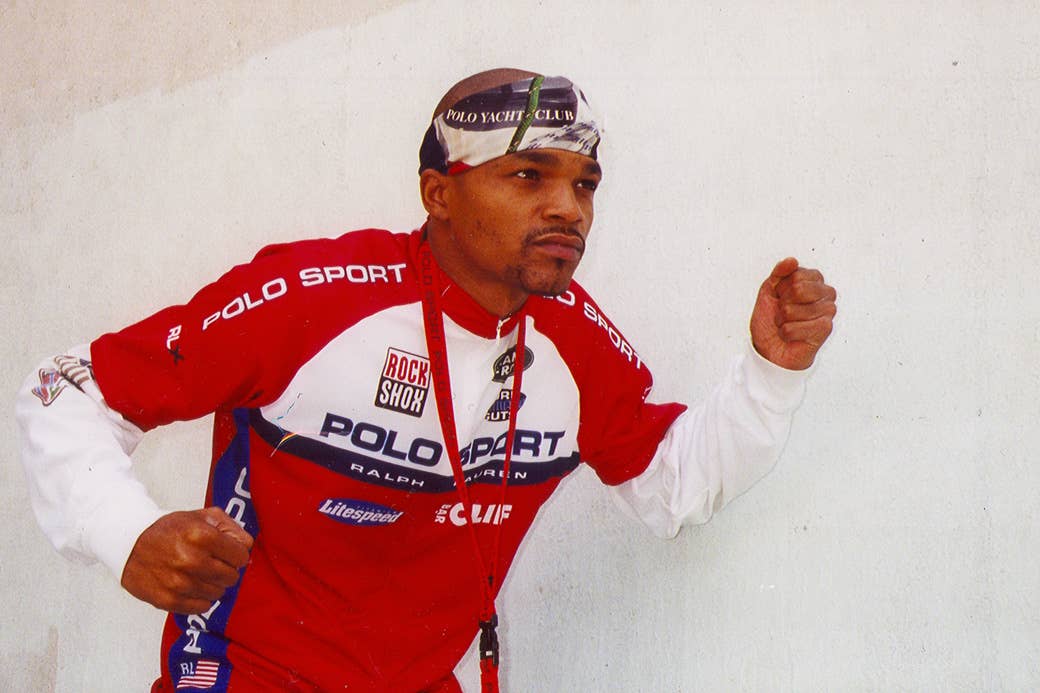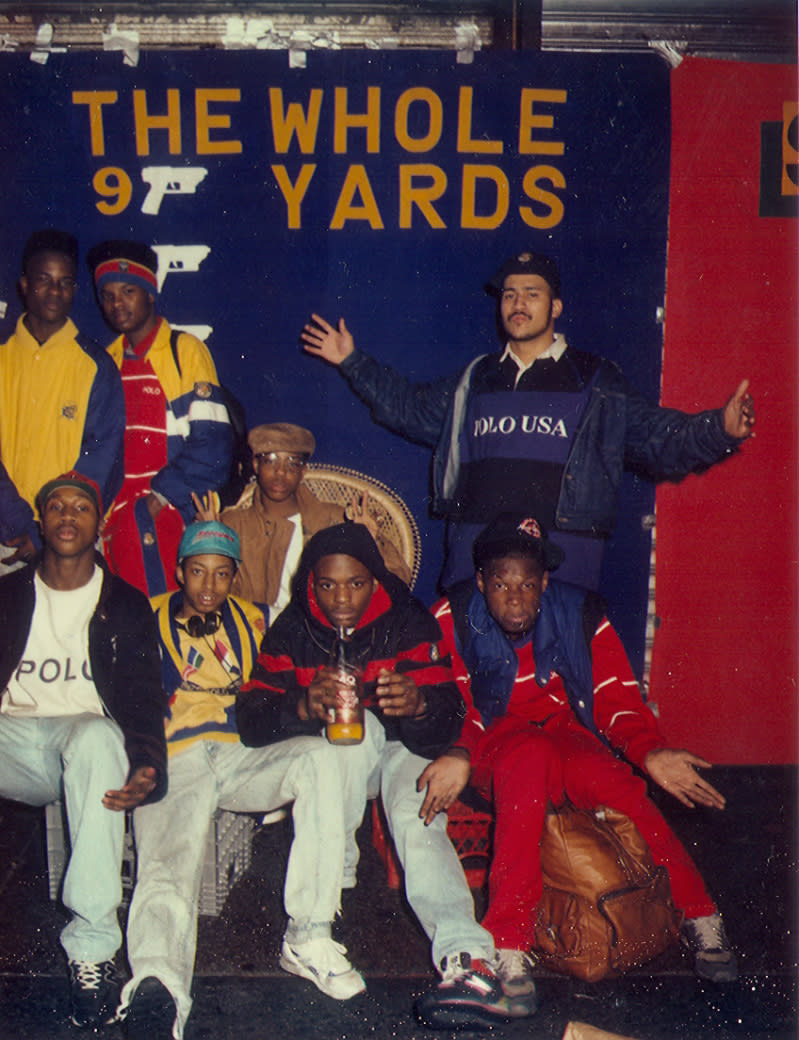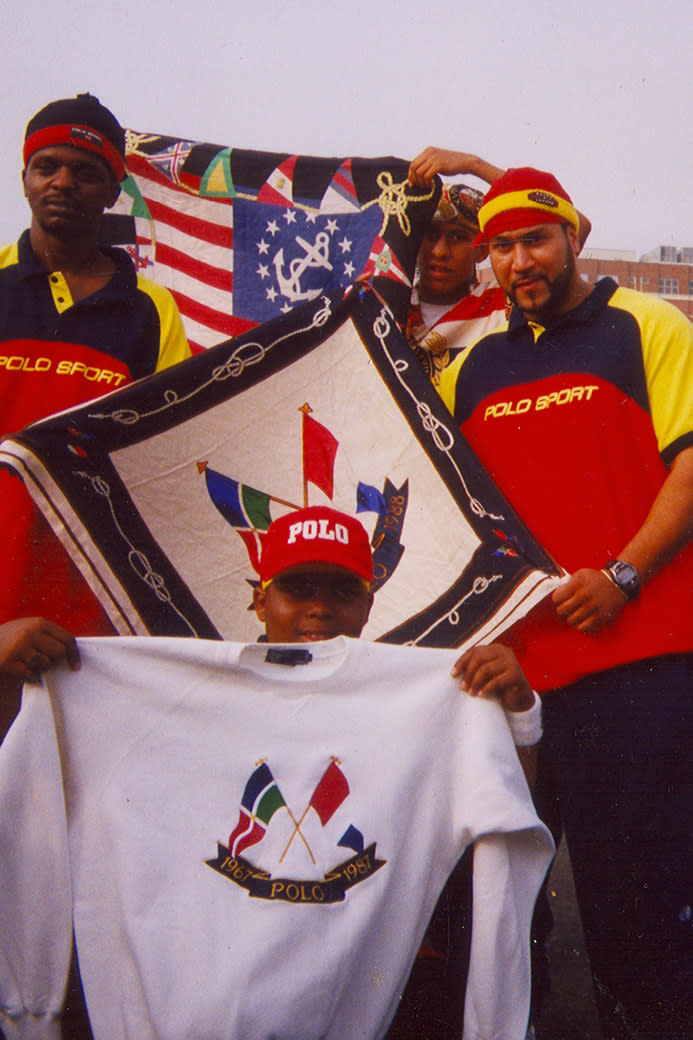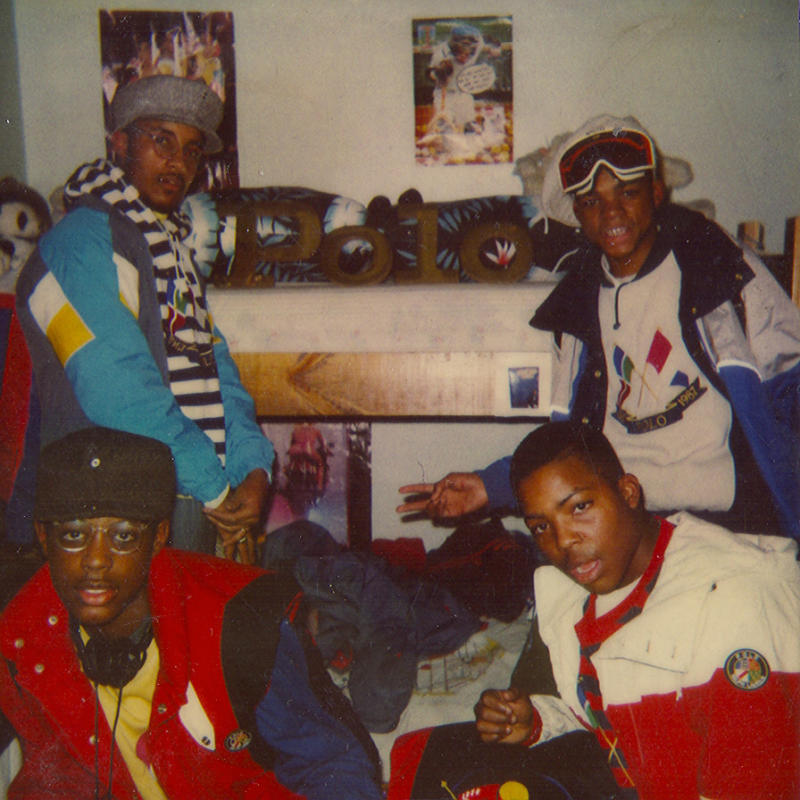
New York was a different place in the ’80s. Times Square—a.k.a. “Forty Deuce”—was littered with pushers, pimps, hoes, peep shows, syringes, and crack vials, a far cry from the advertising Disneyland it is today. It was a playground for Wall Street types, tourists, teenagers looking for a good time, petty criminals looking for a quick come-up, and frequented by various street crews from each of the five boroughs, most notably a Brooklyn collective known as the Lo-Lifes. “We used to meet up there to show off what we had and what we caught.” says founding member Rudy-Lo, who refers to himself as “Puerto Rican Rudy from Flatbush” to differentiate himself from another Rudy-Lo. He continues: “We would be like 25 deep and go into movie theatres with 40 ounces and not pay. That’s how we got our name on the Deuce.”
Unsuspecting tourists and chumps too eager to flaunt the day’s latest threads were preyed upon by opportunistic locals. Dookie rope chains were being snatched on the daily, and various coats were game, especially shearlings and jackets the streets referred to as “Suicides.” Suicides were usually pricey outerwear made by an affluent brand. These days, the NYC youth are putting themselves in harm’s way whenever they rock Marmot Mammoth Parkas, a.k.a. Biggies. Internet personality and Brooklyn native Dallas Penn confirms: “A kid walking around today in a Marmot jacket might get sent up by some other teenagers because that’s coveted heavy right now.”
But the jacket the term was associated to the most back in those days was the Ski ’92 Polo jacket. "We called that the ‘suicide’ ski jacket because if you wore that out in the street it was like suicide. You would probably get killed for it,” super-producer Just Blaze tells Complex in a 2012 interview.

The ghetto eats its young. Some kids are raised in savage environments, forcing them stay on the defensive. Anybody could get got, especially in those days. Lo-Life founder and rapper Thirstin Howl the 3rd remembers: “A lot of us were going to prison at an early age. You grow up in prison meeting the savages from every borough. Once you leave prison, you hang out with these same savages.”
There was a code of honor within the collective. “You could really trust people. Everybody had a lot of respect and honor for each other,” Thirstin continues. Inner city youth tend to move in a unit, whether it be in a gang, clique, crew, block, whatever. They come from broken homes and seek a sense of security. Running with the wolves is a safer bet. Most would rather be on the winning side of a stick-up.

“We always had a heavy emphasis on 'LO. It made us exclusive. The colors stood out and people were able to identify us. Polo became a uniform.”
—Rack-Lo
 Formed during the ’80s, the Lo-Lifes consist of two Brooklyn crews. But it wasn’t until 1988 that they officially became the Lo-Lifes. The name came from Thirtin’s ex-girlfriend. During a night out, she caught him getting another girl’s number and said: “That’s some lowlife shit.” A light bulb lit up over Thirstin’s head and he answered: “Yeah, you’re right. ’Lo is our life.” The name stuck. One half of the BK collective reps the Marcus Garvey Village in Brownsville, while the other rides in the name of St. John’s and Utica in Crown Heights. The former called themselves United Shoplifter’s Association, a.k.a. Polo U.S.A. while the latter went by Ralphie’s Kids. Each crew had a fix for getting fly at your expense. They stole and robbed to either rock or sell whatever apparel they acquired.
Formed during the ’80s, the Lo-Lifes consist of two Brooklyn crews. But it wasn’t until 1988 that they officially became the Lo-Lifes. The name came from Thirtin’s ex-girlfriend. During a night out, she caught him getting another girl’s number and said: “That’s some lowlife shit.” A light bulb lit up over Thirstin’s head and he answered: “Yeah, you’re right. ’Lo is our life.” The name stuck. One half of the BK collective reps the Marcus Garvey Village in Brownsville, while the other rides in the name of St. John’s and Utica in Crown Heights. The former called themselves United Shoplifter’s Association, a.k.a. Polo U.S.A. while the latter went by Ralphie’s Kids. Each crew had a fix for getting fly at your expense. They stole and robbed to either rock or sell whatever apparel they acquired.
Lo-Life co-founder Rack-Lo received his moniker for his uncanny shoplifting ability. Boosting and racking are slang words for stealing. The term “boost” is usually attributed to those who steal for money while the term “rack” is usually used by those who steal for sport or necessity. Both words mean essentially the same thing nonetheless. “We used to be graffiti writers, so we would rack cans. One day we were in Jersey and figured if we could rack cans we can rack clothes,” Rudy-Lo recalls from his days as a booster. He continued, “The first clothes we took were Benetton. Then we did Guess, Tommy [Hilfiger], and Polo stores. Polo got the most attention, though, so we would get that the most. We took ladies’ clothes, too. We would go to nail and hair salons to sell them. Sometimes we would even sell clothes on the train going home.”
Not every Lo-Life member was into that lifestyle, though. Regular joes were down as well. “I would say about 75 percent of the people that was cliqued up with us in some way or another went boosting or robbing: snatching chains, dumping pockets, something,” Rack-Lo recalls. “But not everybody was into that lifestyle. You had guys that held down 9-to-5s.”
One misconception is that the Lo-Lifes exclusively rocked Polo. “We wore everything. It didn’t start with Polo. We were doing this from adidas and Puma suits,” Thirstin states. Rack-Lo backs him up, and adds some other brands into the mix: “We wore FILA, we wore Guess, we rocked Nautica, DKNY, but we always had a heavy emphasis on ’Lo. That was the main one. It made us exclusive. The colors stood out and people were able to identify us. Polo became a uniform.”

It may not have been the only brand they rocked, but Polo had a special meaning for the squad, which always aspired to a better life. The crew, with its mantra of “love and loyalty,” helped individuals remain a unit despite their chaotic environment and kept them focused on upward mobility. Ralph Lauren clothing represented that life.
Born Ralph Lifshitz to Jewish immigrants in the Bronx, the famous designer had aspirations of his own, and the Lo-Lifes relate to them. Dallas had an interesting take on the man behind the brand: “Dude changed his name from Lifshitz to Lauren so he could be a Eurocentric WASP,” he says. “Those were his aspirations. His aspiration was not to be 'Ralphie from the Bronx' or 'Ralphie from Brownsville.' That’s how he maintained the luxury status of his brand.”

 In the ghetto, children don’t grow up playing polo, sailing or skiing, so a brand like Polo helps them project a sense of affluence. In a 2012 interview with Put This On’s Jesse Thorn, Dallas suggests that no one in the hood knew what the sport of polo was before Ralph Lauren came along. The aspiration wasn’t the only factor, though. The Lo-Lifes really did appreciate the designs, and vibrant colors of late ’80s, early ’90s Polo. “We call it ‘rock-it science,’ because there’s a science behind it,” Solace says. Anybody could wear Polo, what made you stand out was how you threw everything together.
In the ghetto, children don’t grow up playing polo, sailing or skiing, so a brand like Polo helps them project a sense of affluence. In a 2012 interview with Put This On’s Jesse Thorn, Dallas suggests that no one in the hood knew what the sport of polo was before Ralph Lauren came along. The aspiration wasn’t the only factor, though. The Lo-Lifes really did appreciate the designs, and vibrant colors of late ’80s, early ’90s Polo. “We call it ‘rock-it science,’ because there’s a science behind it,” Solace says. Anybody could wear Polo, what made you stand out was how you threw everything together.
“You’d see somebody on the street with the exact outfit, but it wouldn't look the same,” Thirstin adds.
To outsiders, boosters may seem like simple thieves, but in the hood they help decrease the gap between the rich and the poor. What’s that Jigga line? “Boosters in abundance, buy a half-price sweater new.” They made luxury brands more affordable.

“Boosters fed the hood, they had it for cheap,” Dallas says. Boosters leveled the playing field for the 9-to-5ers, creating a trickle-down effect. The hustlers, boosters, and stick-up kids stood on pedestals for most kids growing up in an environment where role models were scarce. The ones who fearlessly ran the streets were their symbols of aspiration. They looked up to the guys with the girls, money, clothes, and cars—not Cliff Huxtable or Uncle Phil.
The younger generation looked up to crews like the Lo-Lifes. Solace, a Lo-Lifer and Queens MC from the rap group Timeless Truth, was born in ’88, Polo’s heyday for most. He remembers being influenced by his elders: “We grew up watching the older dudes and our cousins rocking classic pieces, so we took notes. That was us before we got put down with Lo-Lifes. We were seeing these dudes fucking wearing somebody else’s rent like it’s nothing.”
The Lo-Lifes are global now thanks to the Internet and Thirstin’s rap career. “A lot of the spread came from me doing the music—I was never an artist back in the days when we were heavy in the criminal stuff,” he says. “It was developing in all these different countries. [In] Australia, they would get my CDs in prison.”
When Timeless Truth put together the video for their song “Wherever We Go,” it was an international collaboration. “We had kids from Japan, and Spain, and New Zealand who all rock ’Lo contribute to the video,” says Solace. “It’s crazy because you see these dudes walk like us and dress like us. It’s a global movement. It’s a wave. Geography doesn’t matter.”

Thirstin took notice of the crew’s growth and influence and shifted its focus. “I was honored that it was growing but we started to make a big transition once it started changing,” he says. “I started reinforcing the positive aspect of letting people know we’re not glorifying the stuff we did in the past.”
This isn’t your O.G. uncle’s NYC street crew anymore. In 2015, 27 years after Thirstin’s epiphany, the Lo-Lifes are represented on at least four continents. There are Lo-Lifes in Japan, London, Australia, and America. Their annual Brooklyn BBQ has been going for 10 years strong. The crew organizes regular meet-ups in New York, most notably, “’Lo Goose on the Deuce.” It’s one of their bigger events and allows ’Lo heads new and old to show off their favorite pieces. Rack-Lo started the event in the late ’80s and it was originally called “Weekend Madness” because it happened on Friday and Saturday nights.
In a column Rack-Lo wrote for Frank151 back in 2013, the Lo-Life co-founder explained the early days of the event: “Whether it was wearing the latest and greatest in Polo Ralph Lauren wears, posing for timeless fashion photos, rapping to girls, drinking 40 ounces, taking money, meeting new people, viewing new movies at the theaters, partying and/or celebrating, we did it on The Deuce,” he writes. “And 75 percent of the time, we wore Polo gooses in different styles.”
Now, people from all over the world fly in for both events.
“Both events are open to everybody. You get to meet people from Japan, Germany, Canada, London, Australia—everywhere,” says Rudy-Lo. “You can bring gear that you want to trade or sell, and you can buy music from guys like Meyhem Lauren, Fila, and Thirstin. We connect with people and stay in touch through Facebook.”
The Brooklyn BBQ and 'Lo Goose on the Deuce now serve another purpose: educating future generations of 'Lo heads. Later in his Frank 151 article, Rack-Lo explains how the events allow “the newer generation to experience the origin of the lifestyle and its various elements and chapters, but also to meet and break bread with the founders and architects of the movement.”

Polo’s dedication to quality has a lasting effect on those who have loved the brand throughout the years. John Green, who goes by the alias Polo Pirate, earned his nickname due to his many tattoos and extensive Polo collection. He has been a Lo-Life since 1993. He’s one of many O.G.s that still appreciates the brand today. His favorite Polo era was the ‘90s, a time before big pony logos and diffusion lines like Rugby Ralph Lauren and Ralph Lauren Denim & Supply. The visual language of that specific time in Polo's history can still be felt today.
“They’ll bring back some of those pieces and just tweak and remix them,” Green says. “I love the classic Polo Bear design, but my all-time favorite pieces come from the ‘Respect Wildlife’ line. They have the cookie [Lo-Life slang for a circular, biscuit-shaped Polo patch] with a deer and rainbow colors in it.”
The clothing line is still widely popular today. A year ago, the online community of 'Lo heads went nuts when a Polo Ralph Lauren employee code offering a 60 percent discount leaked—a breach the company honored amounting to thousands of happy customers and loyalists. It was quickly dubbed #PoloGate.
“Polo is more diverse these days,” says Green. “Back then it catered to certain people. I think now, after growing and going global, they’ve learned their demographic.”

 Like many hip-hop artists, the crew has helped popularize a brand while expecting nothing in return. All they ever wanted was to dress in fly shit. To Ralph Lauren, these kids may seem like a market segment, but to these kids from Brooklyn, Ralph Lauren is a way of life. Thirstin, who admits he's not into collecting vintage Polo pieces, had been looking for a way to channel the nostalgia of iconic Polo graphics while taking them into the present.
Like many hip-hop artists, the crew has helped popularize a brand while expecting nothing in return. All they ever wanted was to dress in fly shit. To Ralph Lauren, these kids may seem like a market segment, but to these kids from Brooklyn, Ralph Lauren is a way of life. Thirstin, who admits he's not into collecting vintage Polo pieces, had been looking for a way to channel the nostalgia of iconic Polo graphics while taking them into the present.
“I’m excited when I see the new creations,” he says. “Most of my vintage shit, I wear it and people offer me crazy amounts of money, so I sell it off my back.”
With streetwear and high fashion looks merging more than ever before, it's the ideal time for the Lo Lifes to turn their movement into a clothing line. Just a few months ago, Thirstin announced the launch of the Lo-Life collection. The heavily Polo-inspired clothing brand applies the streetwear trope of taking existing designs and flipping them with a knowing, cultural nod. The P-Wing graphic is flipped with double L's in the background, and the Lo-Life rendition of the Polo cookie patch features the crew's motto: “Love & Loyalty.”
Thirstin has big plans for the collection, and even tapped Coogi creative director and street fashion veteran Willie Esco to collaborate on the line. The Lo-Lifes are a big reason for the Ralph Lauren’s popularity in the inner city and beyond, and they hope to bring that same fervent self-promotion to the Lo-Life line.
“We’re going to glorify our brand and put it in the spotlight, the same way we did for Ralph Lauren all these years,” he says.

